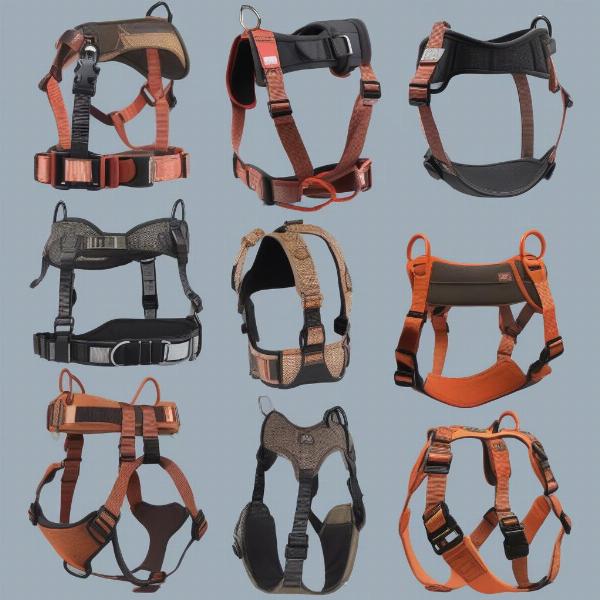A tough dog harness is more than just a walking accessory; it’s an essential piece of equipment for safety, training, and control, particularly for strong or energetic dogs. Choosing the right one can be overwhelming with so many options available. This guide will delve into the key factors to consider when selecting a tough dog harness, ensuring a comfortable and secure fit for your canine companion. From understanding different harness types to considering your dog’s specific needs, we’ll cover everything you need to know to make an informed decision.
Types of Tough Dog Harnesses
Understanding the various types of harnesses is crucial for selecting the right one for your dog’s needs and your training goals. Each type offers distinct benefits and drawbacks.
Front-Clip Harnesses
Front-clip harnesses attach the leash to the dog’s chest. This design can be helpful for discouraging pulling, as it gently steers the dog back towards you when they strain on the leash.
Back-Clip Harnesses
Back-clip harnesses are the most traditional type, with the leash attaching to a ring on the dog’s back. They are generally comfortable for everyday walks and suitable for dogs who don’t pull excessively.
Dual-Clip Harnesses
Dual-clip harnesses offer the versatility of both front and back leash attachments. This allows you to switch between the two depending on the situation, providing flexibility in training and control.
No-Pull Harnesses
Specifically designed to deter pulling, no-pull harnesses often feature a front clip and sometimes incorporate additional features like tightened straps or gentle pressure points to discourage pulling behavior.
 A collage showing various types of dog harnesses: front-clip, back-clip, dual-clip, and no-pull.
A collage showing various types of dog harnesses: front-clip, back-clip, dual-clip, and no-pull.
Sizing and Fit: A Crucial Consideration
A properly fitted harness is paramount for both comfort and effectiveness. A harness that’s too tight can restrict movement and cause discomfort, while one that’s too loose can allow your dog to slip out.
Measuring Your Dog
Accurate measurements are essential for choosing the correct harness size. Use a flexible measuring tape to measure around your dog’s chest, just behind the front legs, and around their neck. Refer to the manufacturer’s sizing chart for the specific harness you’re considering, as sizes can vary between brands.
Adjustability is Key
Look for harnesses with multiple adjustment points. This allows you to customize the fit for your dog’s unique body shape and ensure a secure and comfortable fit.
Material Matters: Durability and Comfort
The material of the harness plays a significant role in its durability and comfort.
Nylon and Polyester
Nylon and polyester are popular choices for their strength, durability, and water resistance. They are relatively easy to clean and maintain.
Leather
Leather harnesses offer a classic and stylish look, but they require more care and maintenance than synthetic materials. They can also be more expensive.
Neoprene Padding
Neoprene padding adds extra comfort, especially for dogs with sensitive skin or who wear their harness for extended periods.
Special Considerations for Active Dogs
For highly active dogs, or those who participate in activities like hiking or running, consider harnesses with additional features.
Reflective Strips
Reflective strips enhance visibility in low-light conditions, keeping your dog safe during evening walks or outdoor adventures.
Handles
A sturdy handle on the back of the harness provides extra control in challenging situations, or for helping your dog over obstacles.
What About a Tough Dog Harness for Puppies?
Puppies, while not as strong as adult dogs, still benefit from a well-fitted harness, especially during training. Look for lightweight, adjustable harnesses designed specifically for puppies.
Conclusion: Finding the Perfect Tough Dog Harness
Choosing a tough dog harness involves careful consideration of your dog’s size, breed, activity level, and training needs. By understanding the different types of harnesses available and focusing on factors like fit, material, and features, you can find the perfect harness to ensure your dog’s comfort, safety, and control. Remember, a well-chosen harness is an investment in your dog’s well-being and your peace of mind.
FAQ
- How do I know if a harness fits my dog correctly? You should be able to fit two fingers between the harness and your dog’s body.
- What’s the best harness for a dog that pulls? A front-clip or no-pull harness can be helpful for dogs that pull.
- Can puppies wear harnesses? Yes, puppies can wear harnesses, but choose one specifically designed for their size and age.
- How do I clean a dog harness? Most harnesses can be hand-washed with mild soap and water.
- Are leather harnesses better than nylon? Both have pros and cons. Leather is stylish but requires more care, while nylon is durable and easy to clean.
- What are the benefits of a dual-clip harness? Dual-clip harnesses offer the flexibility of both front and back leash attachments.
- Do I need a harness with a handle? A handle can be helpful for extra control in certain situations.
About ILM Dog
ILM Dog is your trusted international resource for all things dog-related. We offer expert advice and practical tips on everything from choosing the right breed to ensuring your dog’s health and well-being. We are dedicated to providing valuable insights into dog breeds, health, training, nutrition, and much more. Contact us for all your canine-related inquiries: Email: [email protected], Phone: +44 20-3965-8624.